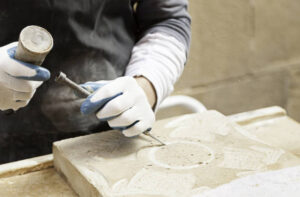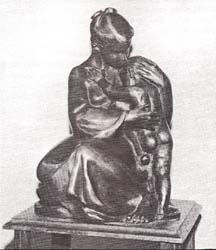
Home » Journal Articles » Thoughts & Opinions » Sculpture as an Art – July/Aug 1997
During my affiliation with Northwest Stone Sculptors Association, I have been asked various questions by several members about the concept of sculpture and the sculpting process. I decided to answer some of these questions to the best of my knowledge in our newsletter. 
First let’s identify the meaning of sculpture itself. The word “sculpture” comes from the Latin word “sculpto” which means carving. The contemporary meaning of sculpture is broader than that. Sculpture has become the art of carving, modeling or assembling some kind of permanent material into a three-dimensional work of art. Sculpture mainly has depicted humans, animals, and objects. The key words in this definition – work of art • are what separates fine sculpture from craft and functional art. It does not mean that a work of art carmot be incorporated into functional art.
Several types of sculpture depend on the relationship of the first two dimensions to the third dimension. If all three dimensions of the sculpture are equal and represent the same relationship as in real life, it is called round sculpture. If the sculpted image is attached to any surface, it is called relief. There are no specific rules how deep a relief should be. However, depending on the scale of the third dimension to the other dimensions, it can be classified as a high relief (1 to 1 to 1), medium relief (around 0.5 to I to I) or low relief (up to 1/4 inch height from the surface of background). When the third dimension was not considered important, sculpture gave life to several applied arts, such as coinage, chasing metals, ornamenting and inlaid work.
Since art began, the human being remains its main theme, From century to century, human life, appearance and man’s activities were reflected in art. An aspiration to capture man’s charm, beauty and intrinsic value begot so many of the noble and perfect works of art. The human body will continue to be a subject for sculptors. Its unlimited numbers of poses and motions provide constant sources of inspiration for the artist.
Any standing or sitting positions are not just a mechanical combination of tension and relaxation of muscles there is also a psychological aspect in them as well. Any psychological process, any reactions in the human brain to its surrounds have a specific reflection in body move· ment or position. There is always a correlation between human psychology, physiology and surrounds. Understanding of this concept along with deep knowledge of human anatomy allow many sculptors to express their own emotional concepts, feelings and philosophy through the depiction of the human body.
Artists are excited about animal forms, movements and appearances also. According to Auguste Rodin, “To any artist, worthy of the name, all in nature is beautiful, because his eyes, fearlessly accepting all exterior truth, read there, as in an open book, all the inner truth.”
Sculpture is the most accessible type of art for the public and, became of that, it is one of the most important type of art. Done in permanent materials as stone or bronze, sculpture became part of mankind’s history. It has become a messenger that passes the word of humanity from generation to generation.
There are three main stages of creating sculpture: modeling, molding and converting the sculpture into intermediate material like plaster and manufacturing it in a permanent material.
Modeling is the most common process to create sculpture. Modeling means creating three-dimensional forms out of modeling materials. As a result of applying specific modeling methods to a sculptural surface, the sculpted model obtains a chiaroscuro effect. Good modeling can create, as Rodin said, “a symphony in black and white ” The main material for modeling is a clay (or other modeling materials based on clay such as a type of oil clay or wax itself).
In contrast to painting, sculpture in clay done by the artist is not a final product yet because unfired clay is not a permanent material and a clay model cannot be preserved for a long period of time. The model should be converted to a hard material in order to preserve the design. The process involves several steps, depending on the final material chosen. Most often a sculptor converts the clay model into bronze or stone.
There are no recipes on how to sculpt but many methods can be useful for beginners and professionals. Composition is the key to the appearance of a sculpture. Good composition means the right relationship among the three dimensions of the sculpture and existence of the main line and mass, that subordiuates all other parts of the composition. It is supplemented by the clear contour of the sculpture that is readable from a distance and attracts attention from all around A good drawing helps improve the qnality of the sculpture. Each sculptor creates an image in his/her own way. During the process of sculpting, some features are selected and the rest ignored because they are not important from the artist’s point of view or do not meet hislher philosophy and temperament. From the selection of the model up to finishing and installation, the sculptor shows hislher outlook. philosophy and interests. That is why we very often can say that artists express themselves through their art work.
There are several peculiarities in the sculpting process. The main goal of the process of sculpting is to represent an artistic image. In the process of creating a sculpture, the artist imprints his idea in drawing. It represents his idea of composition and the appearance of the sculptnre in a given environment. This is a first step in creating a sculpture. It is extremely important to study composition and work it into the drawing especially for commission work when a client requests the sketch to see an artist’s concept. This is a thinking process. When a final idea has been decided upon, the artist uses the sketch to evolve the idea into a clay scale model (maquette). Now our original idea is composed of three dimensions rather than just two. The next step is to enlarge it to final scale. The third step, in most cases, is making the mold and casting the model out of plaster. It is the artist’s copy and serves as a master model. It is also an intermediate material between the clay model and a final product. The last step is converting a sculpture into permanent material such as stone, bronze (or another metal), wood, plastic, etc. to preserve the sculpture. A sculpture should be installed on a base.
As one can see from this short list, the artist has to have skills in several different crafts: the artist must have a good interpretation of casting and metal work, the molding process and molding materials, armature design, knowledge of mechanical tools. base design, construction and installation. All that work cannot be done in the kitchen. The sculptor needs a space for equipment and tools to create and manufacture the sculpture. (See my article “The ideal sculpture studio in January 1997 issue.)
The process of creating a sculpture depends on several different aspects. How large will the sculpture be? What material will be used for its manufacture? Where will it be installed – inside or outdoors? These questions should be answered during the first stages of the work. Each material requires a different design. Bronze is more forgiving for showing dramatic motions and indirectly supported masses. Stone requires a more monumental and stable composition. The scale factor dictates the type of composition and modeling methods.
Installation of three-dimensional outdoor art work is another main task. The sculptor must play an active role in all processes from choosing the location up to the installation
itself. Usually outdoor sculpture is a focal point in the landscape. It becomes a part of the bigger composition that includes surrounding structures. trees or landscape and must be visible from different points of the area. The installation itself must be strictly sound and safe for people walking close or even climbing on the sculpture. By legislation. the sculPtor is responsible for the safety of the installation for the lifetime of the outdoor sculpture.
To be an artist is a privilege and brings the responsibility to serve the altar of humanity, truth and beauty — the greatest hope of all times. It is a complicated and responsible position in society. ” … for the word artist. in its widest acceptance, means to me,” according to Rodin, “the man who takes pleasure in what he does, .. and I completely agree with that.
I wish you all happy sculpting.
Sculpture … has become a messenger that passes the word a/humanity from generation to generation.

We need some kind of descriptive text here.